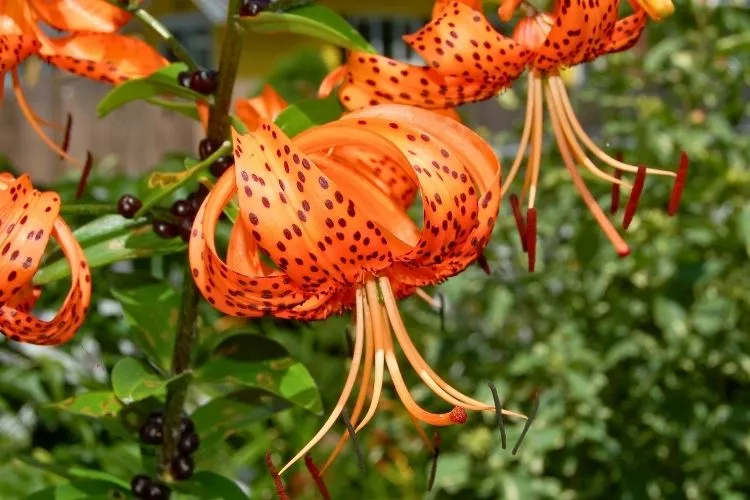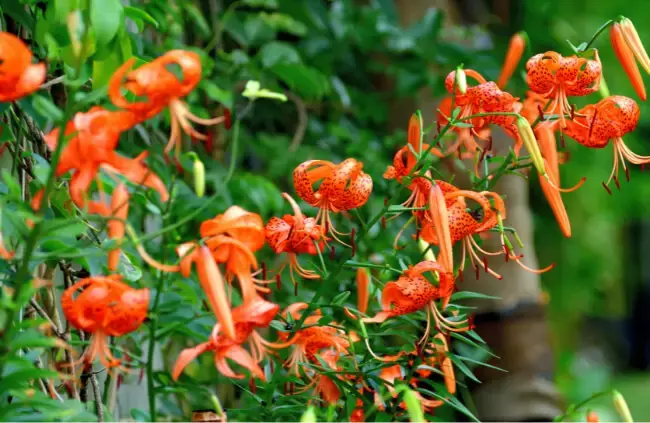Tiger Lilies, known for their vibrant orange blossoms and striking black spots, are a visual delight in any garden.
Although admired for their beauty, these perennials have a secret: they’re capable of rapid growth and expansion.
So, exactly how fast do tiger lilies spread?
In this article, we will explore the speed at which Tiger Lilies multiply, discussing factors that contribute to their swift spread, and offering advice on managing their vigor to maintain a balanced and delightful garden display.

How fast do tiger lilies spread?
Tiger Lilies, scientifically named Lilium lancifolium, are fast-growing perennials that spread at a moderate to fast rate, especially in conditions that are ideal for their growth.
Once established, they can multiply quickly through propagation by bulbs, which grow on their stems (bulbils), and through self-seeding if the flowers are not deadheaded. Their spread can be significantly noticeable over a period of two to three years.
However, the exact rate at which they spread can vary depending upon factors such as soil conditions, sunlight exposure, and watering practices. Tiger Lilies typically prefer well-drained soil and full sun to partial shade.
Regular watering without waterlogging can also promote their health and spread. On average, you can expect a Tiger Lily plant to spread to cover an area of 1 to 2 feet in width in a growing season.
Do tiger lilies multiply on their own?
Yes, Tiger Lilies do multiply on their own and quite efficiently at that. This perennial plant grows from bulbs and boasts a moderate to fast growth rate, which allows it to multiply naturally.
The multiplication process of Tiger Lilies involves the growth of small bulbils on their stem, which fall off, sprout, and grow into new plants. Another way they multiply is through self-seeding.

However, their reproduction is also facilitated with human intervention. Gardeners often propagate Tiger Lilies by dividing the underground bulb. This process, although not necessary for the natural growth of Tiger Lilies, can speed up the multiplication.
These methods, along with the plant’s ability to thrive in various conditions like drought, contribute to the prolific natural multiplication of Tiger Lilies. The often-unhindered growth of these plants lends them their characteristic robust nature and adds to their popularity among gardening enthusiasts.
How do you encourage lilies to multiply?
To encourage lilies to multiply, it’s essential to provide them with the ideal conditions and care. The following detailed guide outlines key steps to promote multiplication in lily plants:

- Choose a suitable location: Lilies require ample sunlight for healthy growth, so it’s ideal to plant them in locations where they can receive 6-8 hours of direct sunlight. You may, however, adjust their location based on your local climate: in hotter regions, consider partial shade to avoid scorching the plants.
- Prepare the soil: Lilies thrive in well-draining, loamy soil with a slightly acidic to neutral pH of 6.5-7.0. If your soil is heavy clay, amend it with organic matter, such as compost or peat moss, to improve drainage. Avoid planting lilies in waterlogged or overly damp locations.
- Plant the bulbs / Choose healthy bulbs carefully: Plant lily bulbs in the fall or spring, depending on your local climate and specific lily variety. Choose bulbs that are firm, without signs of mold or rot, and with intact scales. Plant each bulb 2.5 to 3 times its height deep, spacing them 8-12 inches apart. Take care not to plant them upside down, as this will discourage their multiplication.
- Water and fertilize: Water the lilies consistently, especially during their growth period. Keep the soil moist but not waterlogged. Apply a balanced slow-release fertilizer in early spring, and apply a low-nitrogen, high-potassium fertilizer during the flowering period to encourage bulb multiplication.
- Regular maintenance: Remove faded flowers and dead leaves to ensure that the plant’s energy goes towards bulb multiplication rather than seed production. Make sure to cut down the spent stem only when it has turned completely yellow.
- Mulching: Apply a layer of mulch, about 2-3 inches thick, around the lilies to conserve soil moisture, maintain soil temperature, and suppress weed growth. Use organic mulch, like shredded leaves or compost, for best results.
- Divide lilies: Divide lilies to encourage robust growth. After 3-4 years, the bulbs will have multiplied. Dig up the bulbs carefully, separate the offsets (small bulbs attached to the main bulb), and replant them in a suitable location. This will not only enhance multiplication but also improve the overall health of the plants. Dividing is best done either in the fall or spring, depending on the lily variety.
Following these steps will create the ideal conditions to encourage lily multiplication and ensure a vibrant, flourishing garden.
What time of year do you split lilies?
Lilies are ideally divided or split during early fall, post-flowering and after the foliage has yellowed and died back. This timing enables the roots and bulbs to re-establish prior to winter.
By splitting lilies in the fall, the new divisions have time to develop robust root systems before spring growth resumes.
Dividing the bulbs helps maintain vigorous plants and facilitates propagation. Optimal timing in most northern climates is from September through early October, wrapping up before the first hard frost.
Conclusion:
Tiger Lilies are captivating additions to any garden, with their fast spreading rate contributing to their popularity. Understanding how these perennials multiply and adapting gardening practices accordingly can help maintain their vigor without becoming invasive.
Ensuring ideal conditions and applying proper care will not only support their healthy growth and multiplication but also create a visually spectacular and colorful garden space that all can enjoy and admire.


